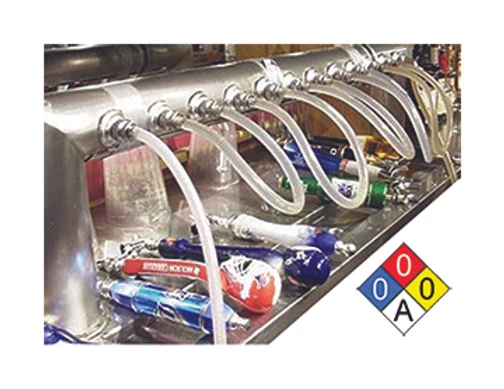Pure Clean Beer! The ultimate goal of clean beer lines. Beer line cleaners are the “behind the scenes” stewards of getting pure, clean beer into beer lovers’ bellies. Let’s keep our beer line cleaners safe! Safe beer line cleaning products are the answer. The goal should be 0-0-0 HMIS. What does this mean?
The Hazardous Materials Identification System (HMIS) is a hazard rating system developed by the American Coatings Association (ACA). It was developed to help employers comply with U.S. Occupational Safety and Health Administration’s (OSHA) workplace labeling requirements.
HMIS directly tells you how safe or hazardous your beer line cleaning chemicals are. This is important information for both employees and employers. Inhaling chemical fumes often causes damage to lungs or the nervous system without the users’ knowledge.
1. How safe is this chemical for skin contact – will it burn me?
2. How safe is this chemical to breathe in – are my lungs, nervous or immune systems
compromised?
3. Is this chemical flammable?
4. What happens if chemical spills?
5. Am I wearing the necessary personal protective equipment (PPE) to protect myself?
Do I know what the required PPE is?
– HMIS is represented by a color-coded, diamond icon.
– The colors of the HMIS diamond are Blue, Red, Yellow, and White.
– They are color-coded to make reading quick and easy.
Within each color category, there are number ratings from 0-4.
Rating Scale
4 – Extreme
3 – High
2 – Moderate
1 – Light
0 – Insignificant
HMIS is important information to understand when using any kind of beer line cleaning chemical. The HMIS should be printed on all chemical bottle labels. All beer line cleaners should know how to interpret this symbol.
Each rating is spelled out below with specifics to each category.
BLUE – Health
The BLUE section rates the health hazards of the material.
4 Life-threatening, major or permanent damage may result from single or repeated over-exposures, for instance, hydrogen cyanide.
3 Major injury is likely unless prompt action is taken and medical treatment is given.
2 A temporary or minor injury may occur.
1 Irritation or minor reversible injury possible.
0 No significant risk to health.
RED – Flammability
The RED section rates the fire and flammability hazards of the material.
4 Flammable gases, or volatile flammable liquids with flash points below 73 °F / 23 °C.
Boiling points below 100 °F / 38 °C. Materials may ignite spontaneously with air.
3 Materials capable of igniting under most normal temperature conditions. Includes flammable liquids with flashpoints below 73 °F / 23 °C. Boiling points above 100 °F / 38 °C. Includes liquids with flashpoints between 73 °F and 100 °F.
2 Materials that must be moderately heated or exposed to high ambient temperatures before ignition will occur. Includes liquids having a flashpoint at or above 100 °F / 38 °C but below 200 °F / 93 °C.
1 Materials that must be preheated before ignition will occur. Includes liquids, solids, and semi-solids having a flashpoint above 200 °F / 93 °C.
0 Materials that will not burn, for instance, water.
YELLOW-ORANGE- Reactivity/Physical Hazard
The YELLOW/ORANGE section rates hazards related to reactivity and physical hazard.
4 Materials, at normal temperature and pressure, that are capable of: explosive water reaction, detonation or explosive decomposition, polymerization, or self-reaction, for instance, chlorine dioxide, nitroglycerin.
3 Materials that may form explosive mixtures with water and are capable of detonation or explosive reaction in the presence of a strong initiating source. Materials may polymerize, decompose, self-react, or undergo other chemical change at normal temperature and pressure with moderate risk of explosion, for instance, ammonium nitrate.
2 Materials that are unstable and may undergo violent chemical changes at normal temperature and pressure with low risk for explosion. Materials may react violently with water or form peroxides upon exposure to air, for instance, potassium, sodium.
1 Materials that are normally stable but can become unstable or self-react at high temperatures and pressures. Materials may react non-violently with water or undergo hazardous polymerization in the absence of inhibitors, for instance, propene.
0 Materials that are normally stable, even under fire conditions, and will not react with water, polymerize, decompose, condense, or self-react. Non-explosives, for instance, helium.
White – Personal Protection Equipment
The WHITE section addresses which PPE should be worn when working with the rated material.
This chart shows clearly what PPE is required when cleaning beer lines.
The HMIS color-coded icon is printed on all chemical bottle labels for the user’s safety. It is important information to understand what the categories and ratings of HMIS mean. At bare minimum, a general understanding is helpful.
Source: www.osha.gov

